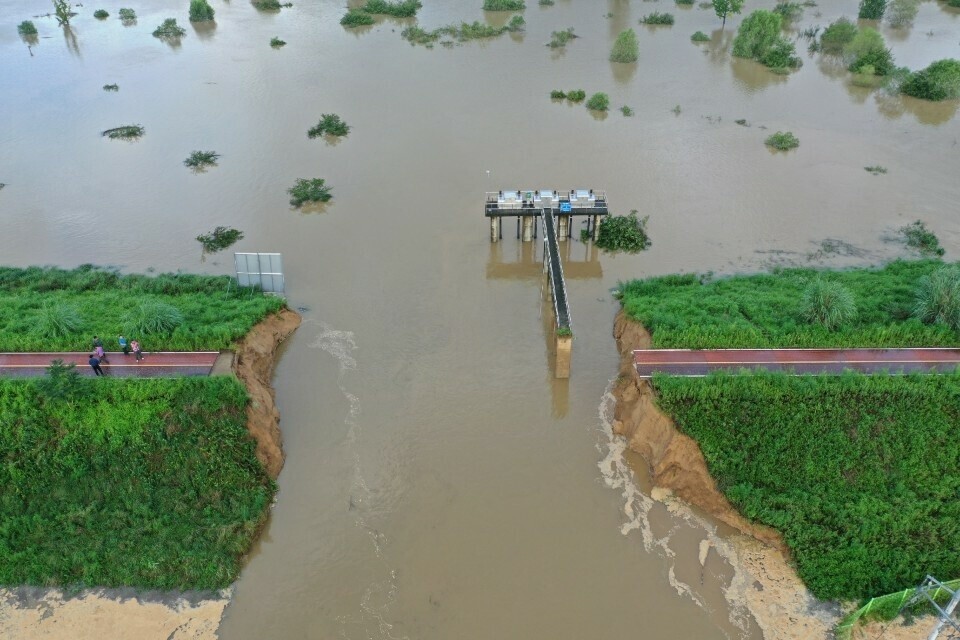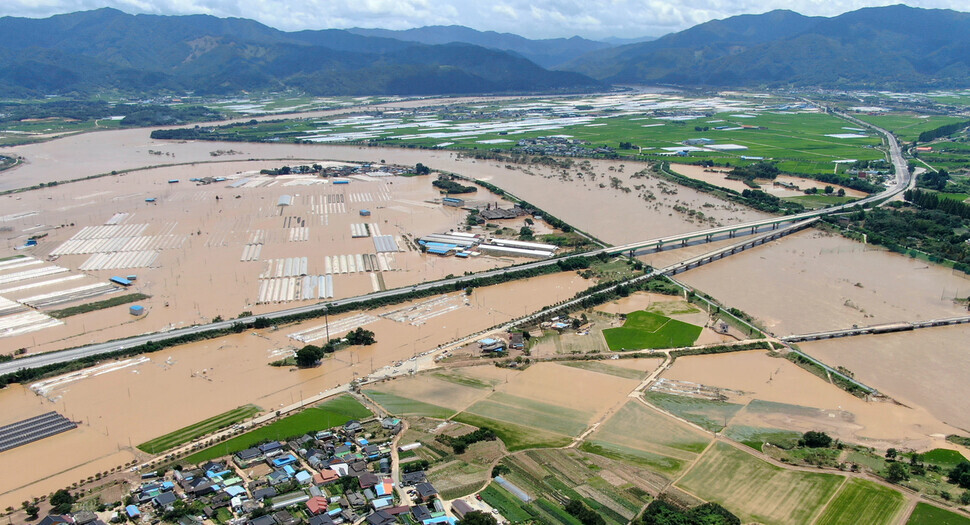hankyoreh
Links to other country sites 다른 나라 사이트 링크
[Editorial] Central, local governments should marshal resources to aid communities ravaged by flooding

All of South Korea has been struggling with torrential rainfall and a historically long monsoon season. On Aug. 7 to 9, heavy rains in the range of 500 millimeters (mm) fell on numerous locations in the south, resulting in levees collapsing on the Seomjin and Nakdong Rivers. Fourteen people have died in the Yeongnam and Honam regions alone, while thousands of others have been evacuated and forced out of their homes.
We can only express our deepest condolences to those residents, who are surely feeling aggrieved and frustrated by this enormous disaster. There should not be any hint of neglect from the central and local governments as they work to console the victims and restore their homes. As the northward movement of Typhoon Jangmi threatens to only compound the losses, they must also be thorough in devising measures to prevent an even greater disaster.
The Yeongnam and Honam regions suffered massive losses amid heavy rains of 400-600 mm that fell on Aug. 7 and 8. The collapse of a levee section on the Seomjin River reportedly resulted in over 3,000 residents along its banks -- including Namwon in North Jeolla Province; Gurye, Gokseong, and Gwangyang in South Jeolla Province; and Hadong in South Gyeongsang Province -- being hurriedly evacuated to safer ground. At Hwagae Market in Hadong, which has been viewed as a symbol of harmony between Yeongnam and Honam, there was a precarious situation at one point as dozens of people were left stranded as water rose to the level of the building’s roof.

Early in the morning on Aug. 9, around 50m of levee along the Hapcheon-Changnyeong Weir in Ibang Township of South Gyeongsang’s Changnyeong County -- located on the main course of the Nakdong River -- gave out under the pressure of waters swollen by torrential rains. Thousands of people were left homeless as villages in Ibang Township were flooded, including Jangcheon, Songgok, and Geonam. Previously, dozens or people were killed or disappeared in central South Korea and the Yeongseo region amid torrential rains that persisted for almost a full week. Thousands of people in seven metropolitan cities and provinces, including Gyeonggi and North and South Chungcheong, were forced to leave their homes and evacuate to gymnasiums, community centers, and other facilities.
Meanwhile, the Korea Meteorological Administration (KMA) predicted that Typhoon Jangmi, the fifth tropical storm of the season, would reach the Korean Peninsula on Aug. 10, dumping rainfall of up to 300 mm on southern South Korea and 500 mm on the central region. These unusual weather patterns constitute a dire emergency. Times like this urgently call for a systematic response and cooperation from the community as a whole. The central government needs to focus its efforts on examining anticipated vulnerabilities and responding swiftly to minimize the damages. It must also be thorough in its future support measures, including the declaration of another special disaster region.
More than anything, we must be careful to ensure that natural disasters are not exacerbated by human actions. Some have been alleging that the reckless mobilization of workers played a part in the Uiam Dam tragedy, while others have drawn connections between the Four Major Rivers Restoration Project and the Changnyeong Weir collapse. These incidents will need to be thoroughly investigated, and measures will have to be taken to prevent similar incidents in the future. The South Korea public, for their part, should reflect on the meaning of “community” as they offer their wholehearted encouragement and support.
Please direct comments or questions to [english@hani.co.kr]

Editorial・opinion
![[Column] Has Korea, too, crossed the Rubicon on China? [Column] Has Korea, too, crossed the Rubicon on China?](https://flexible.img.hani.co.kr/flexible/normal/500/300/imgdb/original/2024/0419/9317135153409185.jpg) [Column] Has Korea, too, crossed the Rubicon on China?
[Column] Has Korea, too, crossed the Rubicon on China?![[Correspondent’s column] In Japan’s alliance with US, echoes of its past alliances with UK [Correspondent’s column] In Japan’s alliance with US, echoes of its past alliances with UK](https://flexible.img.hani.co.kr/flexible/normal/500/300/imgdb/original/2024/0419/2317135166563519.jpg) [Correspondent’s column] In Japan’s alliance with US, echoes of its past alliances with UK
[Correspondent’s column] In Japan’s alliance with US, echoes of its past alliances with UK- [Editorial] Does Yoon think the Korean public is wrong?
- [Editorial] As it bolsters its alliance with US, Japan must be accountable for past
- [Guest essay] Amending the Constitution is Yoon’s key to leaving office in public’s good graces
- [Editorial] 10 years on, lessons of Sewol tragedy must never be forgotten
- [Column] A death blow to Korea’s prosecutor politics
- [Correspondent’s column] The US and the end of Japanese pacifism
- [Guest essay] How Korea turned its trainee doctors into monsters
- [Guest essay] As someone who helped forge Seoul-Moscow ties, their status today troubles me
Most viewed articles
- 1[Column] The clock is ticking for Korea’s first lady
- 2[Correspondent’s column] In Japan’s alliance with US, echoes of its past alliances with UK
- 3After 2 months of delayed, denied medical care, Koreans worry worst may be yet to come
- 4[Column] Has Korea, too, crossed the Rubicon on China?
- 5[Editorial] When the choice is kids or career, Korea will never overcome birth rate woes
- 6Samsung barricades office as unionized workers strike for better conditions
- 7US exploring options for monitoring N. Korean sanctions beyond UN, says envoy
- 8US overtakes China as Korea’s top export market, prompting trade sanction jitters
- 9[Photo] Smile ambassador, you’re on camera
- 10Hong Se-hwa, voice for tolerance whose memoir of exile touched a chord, dies at 76